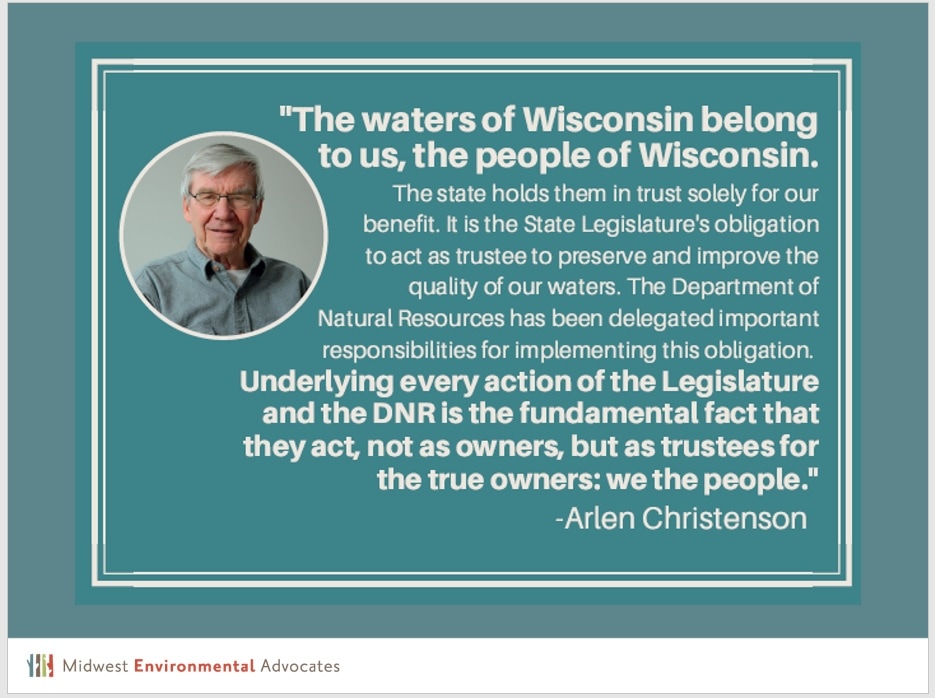|
Kim Wright is the Executive Director of Midwest Environmental Advocates, based in Madison, Wisconsin. She began her talk by telling us that Wisconsin has been a laboratory for understanding the ‘smaller government’ model and what it means for citizens. When government does not do its job protecting its citizens, organizations like Midwest Environmental Advocates step up to help people. The quote below is a statement of rights - the waters of Wisconsin belong to the people of Wisconsin, and the Wisconsin Department of Natural Resoures is to act as trustee protecting these waters for the people. If we don’t all have fair rules to get into the game, we cannot achieve fair outcomes. The people of Wisconsin have a right to clean water. See WisconinWatch’s Failure at the Faucet: (Wisconsin Center for Investigative Journalism)
Wisconsin was a leader in implementing regulations when Clean Water Act was passed. Now a legislative audit found that this program is ignoring it’s own rules. When the state does not enforce, it passes on costs to local governments to protect its citizens. Click here for link to audit. Use the second markers below to find specific elements of Kim's talk. (Click here to see Kim's talk on YouTube.) 5:45 Green Bay (the water body) has a deadzone, an area where there is no oxygen, due to the high levels of nutrients that are being discharged here. People sought to place controls on pollutors in the watershed and worked to challenge paper mill permit. A lawsuit was brought, it made its way to the Wisconsin Supreme Court. Supreme Court ruled that no change was needed. So Midwest Environmental Advocates brought this to US EPA’s attention and asked that the states authority to administer Clean Water Act be rescinded. DNR fought this, but MEA kept up the battle, going back to US EPA with a petition on behalf of 16 citizens who are impacted by contaminated groundwater. ( Click here to read more about this.) 16:00 In 2003, Wisconsin legislature removed the ability of local governments to restrict Combined Animal Feeding Operations (CAFOs, a.k.a. feedlots). This ties back to donations made to politicians. There was a great increase in the number of CAFOs and a decrease in the number of DNR staff to enforce. This was seen in Kewaunee County in northeastern Wisconsin, near Door County where the great number of CAFOs has greatly impacted groundwater. The manure management plans for these farms seemed to be built on imagined possible corn yields, and children have been sickened from the bad water. ( Click here. ) 27:00 Wisconsin passed law that basically exempted iron mining from environmental regulation. This threatened the wild rice beds of the Bad River Band of Ojibwe ( Click here. ) 30:00 Menomonie – the problem with contaminated lakes full of algae is drastically affecting life in this area. The stench of the algae is unbearable in the summer. ( Click here. ) Kim is hopeful because she sees the people of Wisconsin standing up and organizing. Examples are the Citizen’s Water Lobby Day (link to blog story) which is now organized as Citizen Water Council of Wisconsin, Sustain Rural Wisconsin and the Green Fire group of retired DNR and University of Wisconsin scientists. (Click here for more information on Wisconsin Green Fire; click here for information on Sustain Rural Wisconsin.)
0 Comments
Leave a Reply. |
| LWV Upper Mississippi River Region | UMRR blog |

 RSS Feed
RSS Feed